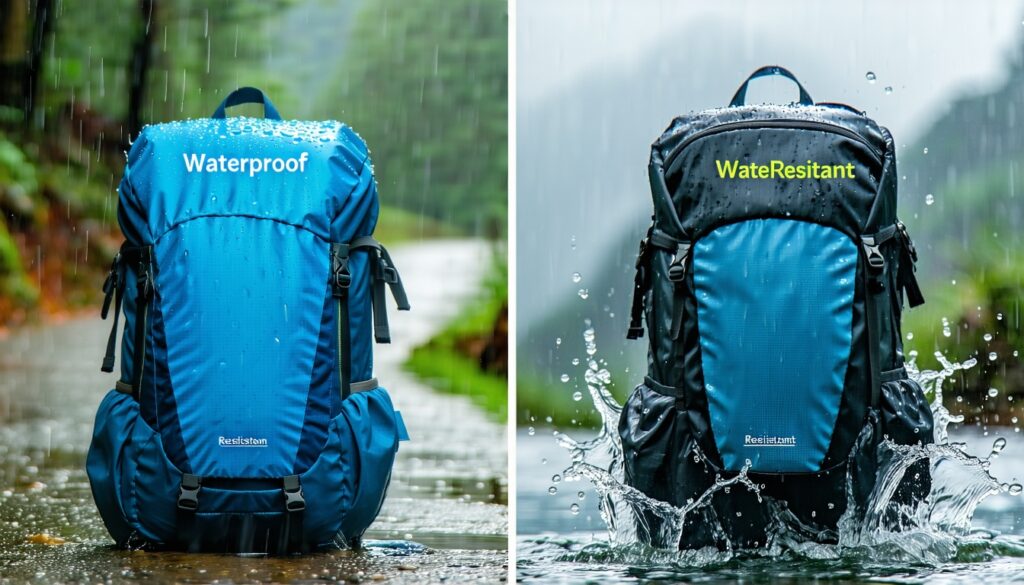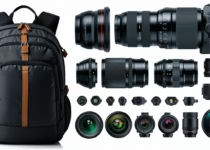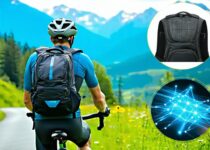What Cyclists Need to Know: Waterproof vs Water-Resistant Backpacks

Understanding Waterproof vs. Water-Resistant
Cyclists often face unpredictable weather conditions, making understanding the differences between waterproof and water-resistant backpacks crucial. Here, we explore these two terms and their significance in the cycling world.
Key Differences
The primary difference between waterproof and water-resistant backpacks lies in their level of protection against water. Waterproof backpacks are specifically constructed to block out all water, ensuring that no moisture can seep inside. They often incorporate sealed seams, waterproof zippers, and roll-top closures to maintain their integrity even in heavy rain.
In contrast, water-resistant backpacks provide only partial protection. While they can handle light rain or splashes, they are not designed for prolonged exposure to heavy moisture. Figuring out the difference can help cyclists make informed decisions based on their riding conditions.
| Backpack Type | Water Protection Level | Key Features |
|---|---|---|
| Waterproof | High | Sealed seams, waterproof zippers, roll-top closures |
| Water-Resistant | Moderate | Water-repellent materials, limited moisture defense |
Materials Used
Waterproof backpacks typically utilize advanced materials that are inherently water-resistant. Common materials used for these durable backpacks include:
- PVC (Polyvinyl Chloride): Known for its strong water resistance.
- TPU (Thermoplastic Polyurethane): Offers flexibility and durability, commonly found in waterproof gear.
- High-Density Laminated Nylon: Provides maximum protection against moisture while remaining lightweight.
Water-resistant backpacks often use fabrics with a Durable Water Repellent (DWR) coating, which allows water to bead up and roll off the surface to some extent. However, once this coating wears off, the level of protection significantly decreases.
Choosing between waterproof vs. water-resistant: choosing bike-safe backpacks can greatly impact your cycling experience, especially when rain is in the forecast. Additionally, consider the specific use case scenarios you encounter to ensure you select a backpack that meets your needs. For further guidance on comfort and ergonomics, check out our article on how to choose an ergonomic cycling backpack for comfort and posture.
Advantages of Waterproof Backpacks
Waterproof backpacks offer numerous benefits, especially for cyclists and outdoor enthusiasts who frequently encounter wet conditions. Understanding these advantages can help users choose the right gear to keep their belongings safe and dry.
Complete Protection
One of the most significant benefits of waterproof backpacks is their ability to provide complete protection against moisture. These bags are constructed from materials that repel water, such as PVC or TPU (thermoplastic polyurethane), and feature sealed seams, waterproof zippers, and roll-top closures that ensure no moisture penetrates the bag. This level of protection is crucial for commuters often caught in the rain or for adventurous cyclists engaging in activities like kayaking or mountain biking.
| Feature | Benefit |
|---|---|
| Sealed seams | Prevent water from entering the bag |
| Waterproof zippers | Ensure no leaks through closures |
| Roll-top design | Allows for adjustable closure to prevent moisture ingress |
Durability Factors
Waterproof backpacks are designed to withstand harsher conditions than their water-resistant counterparts. The materials used in their construction, like high-density laminated nylon, are often thicker and more robust, contributing to the backpack’s longevity. These bags can resist wear and tear from various elements, making them a reliable choice for long-term use. This durability ensures that the bag can handle the rigors of outdoor activities while keeping contents safe.
| Material | Characteristics |
|---|---|
| PVC | High resistance to water |
| TPU | Lightweight yet strong |
| High-density nylon | Durable and long-lasting |
The effectiveness of waterproof backpacks makes them indispensable for those who want to protect valuable items, like electronics and important documents, from water damage. For cyclists, investing in such a bag means greater peace of mind during inclement weather and more secure transportation of gear. Those considering a purchase can explore different options through resources on how to choose an ergonomic cycling backpack for comfort and posture, or consider features like hydration-compatible designs.
Advantages of Water-Resistant Backpacks
When cyclists are in the market for backpacks, water-resistant options often come up. These backpacks offer unique benefits that can be appealing for daily commuting or light recreational rides.
Moderate Protection
Water-resistant backpacks provide a level of protection against moisture but do not offer complete waterproofing. They are designed to guard belongings during light rain or humid conditions. This makes them a practical choice for everyday use, allowing cyclists to tackle unexpected drizzle while keeping their essentials relatively dry.
| Protection Level | Suitable Conditions |
|---|---|
| Water-Resistant | Light rain, humidity |
| Waterproof | Heavy rain, full immersion |
Lightweight Design
One of the standout features of water-resistant backpacks is their lightweight design. Made from treated materials such as nylon or polyester with a durable water-repellent (DWR) coating, these backpacks are easy to carry for long durations. The breathable materials used in their construction not only enhance comfort but also improve airflow, making them ideal for cycling activities.
In comparison to waterproof models, water-resistant backpacks provide a more lightweight option for cyclists who prefer a less cumbersome solution. This feature is especially beneficial for those who pack light and prioritize mobility while riding.
For more information on how to choose the right backpack for your needs, check our guide on how to choose an ergonomic cycling backpack for comfort and posture.
Factors to Consider When Choosing
When cyclists think about backpacks, especially regarding waterproof vs water-resistant: choosing bike-safe backpacks, there are several important factors to consider. It’s essential to evaluate the intended use and how sensitive the gear is that will be packed inside.
Use Case Scenarios
The intended situation in which the backpack will be used plays a significant role in the decision-making process. Cyclists may use bags for various activities, ranging from daily commutes to multi-day bikepacking adventures. Understanding these use case scenarios can help determine whether a waterproof or water-resistant backpack is more suitable.
| Activity Type | Recommended Type | Key Features to Consider |
|---|---|---|
| Daily Commutes | Waterproof | Sealed seams, waterproof zippers, and roll-top closures for protection |
| Hiking | Waterproof | Adjustable capacity and padded laptop sleeves for comfort |
| Casual Riding | Water-resistant | Lightweight and breathable material |
| Water-based Activities | Waterproof | Submersible zippers and lens organizers for gear protection |
| Overnight Trips | Waterproof | Larger capacity (35 liters or more) for bulky items |
Selecting the right type of backpack ensures that cyclists’ gear remains safe and secure, especially in unpredictable weather. For tips on ergonomics, check out our article on how to choose an ergonomic cycling backpack for comfort and posture.
Gear Sensitivity
Cyclists must also consider how sensitive their gear is to moisture. If electronics, cameras, or important documents are being transported, opting for a waterproof backpack is crucial. Waterproof backpacks are designed specifically to block water from entering, often using materials such as PVC, TPU, or high-density laminated nylon, with features like sealed compartments to guarantee maximum protection against moisture.
On the other hand, water-resistant backpacks provide a lower level of protection. They are suitable for situations where the risk of exposure to water is minimal or manageable. However, they won’t protect belongings if fully submerged. For cyclists who often face wet conditions, using a waterproof bag can be essential to safeguarding valuable gear.
When considering the appropriate backpack, understanding the sensitivity of the gear being carried will assist in making an informed choice. For more on the utility of roll-top backpacks in urban cycling, refer to our article on should you use a roll‑top backpack for urban cycling?.
Waterproof Backpack Features
Cyclists need to stay prepared for wet weather conditions when riding. A waterproof backpack can ensure that their gear remains dry and secure. Below are essential features that make waterproof backpacks particularly effective.
Sealed Compartments
Waterproof backpacks are designed with sealed compartments to protect the contents from moisture. These compartments are crafted from high-quality materials like PVC or TPU, which are resistant to water even over extended periods.
| Feature | Description |
|---|---|
| Material | PVC or TPU, ensuring durability and resistance to water |
| Sealing Technology | Sealed seams and compartments to prevent water entry |
| Waterproof Rating | Higher ratings (measured in kPa or mm) indicate better protection against water penetration |
These features are crucial in preventing water from seeping through, especially during heavy rain.
Waterproof Zippers
Waterproof zippers are a critical component of any waterproof backpack. These zippers help to keep water out through potential weak points, which are typically the zippers themselves.
| Feature | Description |
|---|---|
| Functionality | Prevents moisture from damaging the backpack’s contents |
| Durability | Reinforced to withstand wear and tear |
| Compatibility | Ideal for holding sensitive electronics like laptops and cameras |
With waterproof zippers, cyclists can confidently carry their electronics and other essential gear without worrying about moisture damage.
Choosing waterproof backpacks means considering these features to ensure the best performance when cycling in wet weather. For tips on managing your gear effectively, check our guide on how to pack tools snacks and gear in a bike backpack.
Waterproof Backpack Brands
When it comes to selecting the best waterproof backpacks for cycling, two brands stand out in the market: the Patagonia Guidewater Backpack and the YETI Panga 28L Backpack. Both options provide exceptional waterproof features, making them suitable for various outdoor activities, including cycling.
Patagonia Guidewater Backpack
The Patagonia Guidewater Backpack is highly regarded for its durability and waterproof capabilities. This backpack is constructed from a 14.4 oz recycled nylon fabric with a PU and TPU coating. Its design includes external attachment loops, making it versatile for carrying additional gear.
| Feature | Details |
|---|---|
| Material | 14.4 oz recycled nylon with PU and TPU coating |
| Waterproof Level | Fully submersible |
| Certification | Fair Trade Certified |
| Weight | Lightweight for its size |
| Price Range | Relatively high, quality investment |
This backpack’s slick texture and robust construction provide excellent longevity, ensuring that it can withstand wet conditions without compromising its contents. Users have often found that this backpack is not only functional but also well-designed for outdoor enthusiasts engaging in activities like fishing or cycling.
YETI Panga 28L Backpack
The YETI Panga 28L Waterproof Backpack is another remarkable option, known for maintaining a classic backpack silhouette while offering complete waterproofness. This model is capable of submersion in up to a meter of water for 30 minutes, making it ideal for those wanting to safeguard their gear from water damage.
| Feature | Details |
|---|---|
| Design | Boxy design for convenient stacking |
| Waterproof Level | Submersible up to 1 meter for 30 minutes |
| Closure Type | Zipper closure for easy access |
| Sturdy Features | Strong zipper pulls for durability |
Its zipper closure allows for straightforward loading and unloading, creating a practical choice for users who prefer a traditional zipper over a roll-top closure. This backpack is versatile for various biking conditions, benefiting those who need a reliable waterproof option while cycling.
Both the Patagonia Guidewater and YETI Panga 28L backpacks cater to cyclists seeking durable and waterproof solutions. For additional insights into selecting the right backpack for different cycling needs, visit our guide on how to choose an ergonomic cycling backpack for comfort and posture and hydration-compatible cycling backpacks: what to look for.
Water-Resistant Backpack Features
Choosing a water-resistant backpack is important for cyclists who want moderate protection against moisture. These backpacks are built with specific features that enhance their usability while cycling.
Durable Water-Repellent Coating
Water-resistant backpacks are typically crafted from materials like nylon or polyester that are treated with a durable water-repellent (DWR) coating. This special coating helps prevent water from penetrating the fabric, allowing the backpack to resist moisture during light rain or splashes. However, it is essential to note that they do not provide complete waterproof protection.
| Feature | Description |
|---|---|
| Material | Nylon or polyester with DWR coating |
| Protection Level | Moderate; suitable for light rain |
| Weight | Generally lightweight for ease of cycling |
This balance of protection and weight makes water-resistant backpacks an ideal choice for cyclists who want versatility without compromising on comfort.
Breathable Material
In addition to the DWR coating, water-resistant backpacks are often made from breathable materials. This feature facilitates airflow, helping to reduce sweat buildup during rigorous cycling. The breathability of the fabric enhances comfort, especially during long rides.
| Feature | Description |
|---|---|
| Breathability | Allows air circulation to prevent overheating |
| Moisture Management | Helps wick moisture away from the body |
| Usage | Great for warm weather or intense activities |
The combination of durable water-repellent coatings and breathable materials ensures that cyclists remain comfortable and dry when faced with moisture, making water-resistant backpacks a fantastic option for varied riding conditions. For more information on how to keep your gear safe while cycling, check out our guide on how to secure your cycling backpack while riding in traffic.
Water-Resistant Backpack Brands
Choosing the right water-resistant backpack can enhance any cyclist’s experience, ensuring that gear stays dry and secure during rides. Here are two notable brands that offer excellent options for water-resistant backpacks.
MARCHWAY Dry Bag 20L
The MARCHWAY Dry Bag 20L is an ideal choice for budget-conscious cyclists. This lightweight and submersible backpack features a roll-top closure, which enhances waterproofing and keeps gear safe from the elements. Its affordability, typically priced under $30, makes it a favorite among those who need reliable protection without breaking the bank.
| Feature | Specification |
|---|---|
| Volume | 20L |
| Closure Type | Roll-top |
| Price | Under $30 |
| Waterproof | Yes |
| Weight | Lightweight |
The various color options allow cyclists to choose one that reflects their personal style, while its compact size is perfect for short trips or daily commutes.
Earth Pak Summit Dry Bag Backpack 35L
The Earth Pak Summit Dry Bag Backpack 35L is another excellent option for cyclists who require more storage space and durability. This bag features ample back panel padding and a roll-top closure that effectively keeps gear dry. Made from sturdy fabric, it is both waterproof and abrasion-resistant, making it suitable for hiking or other outdoor water activities.
| Feature | Specification |
|---|---|
| Volume | 35L |
| Closure Type | Roll-top |
| Design | Padded back panel |
| Waterproof | Yes |
| Durability | Abrasion-resistant |
The attachment loops on the Earth Pak Summit allow for convenient gear organization, making it a great companion for longer rides or adventures.
When deciding between options, cyclists should consider their specific needs, like capacity and durability, to find the perfect water-resistant backpack for their cycling experiences.


